Leaf curling Spider:The full size of a Leaf Curling Spider is the size of a 50 cent piece. The size of one leg is like a pin. They have a brown body and a creamy yellow abdomen and pale markings. The scientific name for the Leaf Curling Spider is Phonognatha graeffei. Normally the female’s size is about 8mm and the male about 5mm. This species has eight eyes on its cephalothorax, (spiders don’t have heads). The Leaf Curling Spider is an Orb Weaving Spider which means it makes a symmetrical web.
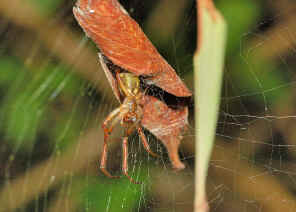
Leaf at first sight: how leaf-curling spiders pair up and build a family home.
Have you recently spotted a spider peeking out from a brown, curled-up leaf in your garden?
This spider – found in each state and territory in Australia – builds its orb web in plants and places in it a special custom-built hiding spot: a curled up leaf.
Similar to other orb-weaving spiders, the leaf-curling spider lives for only one year and is most commonly seen in late summer.
They are found in woodlands as well as urban gardens and greenery and have particularly interesting family arrangements.
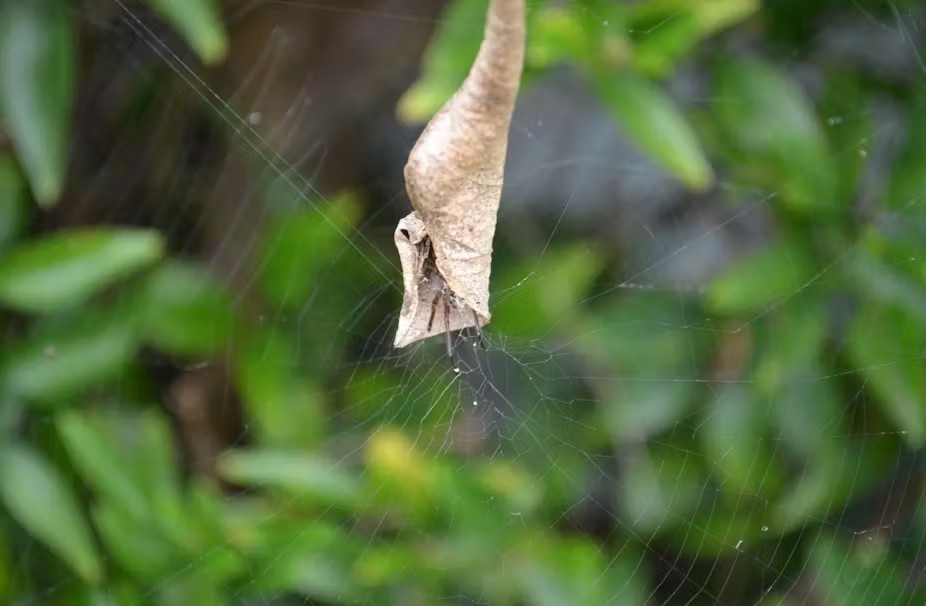
Leaf curling Spider size
Cephalothorax and legs red-brown, abdomen with an irregular creamy-yellow chevroned pattern on the upperside. Stout, oval-shaped abdomen with slender, long legs. Body of males to 5 mm, females to 8 mm long.
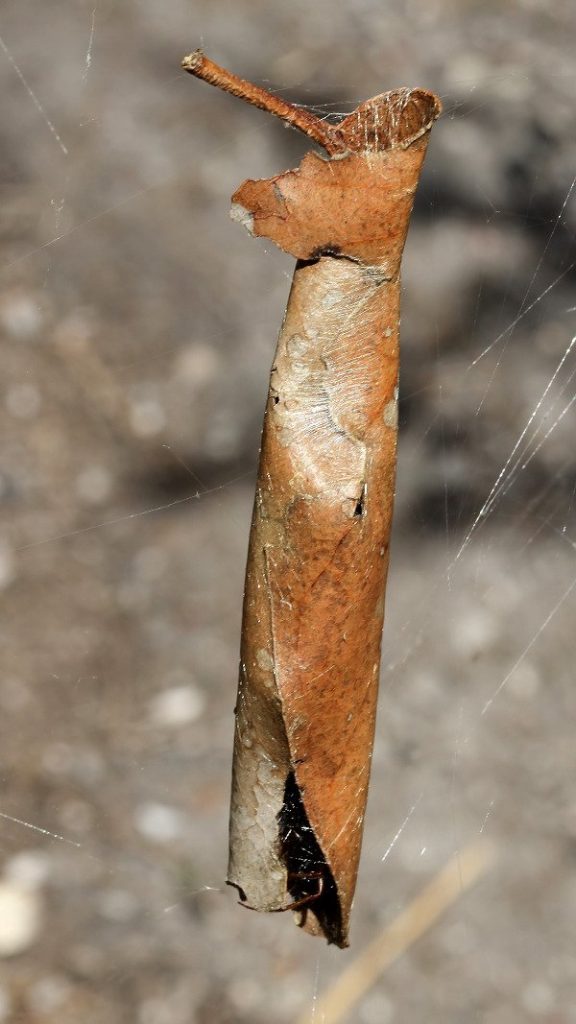
Family: Araneidae (Orb-weavers)
Size: Male body size 5 to 6 mm, female body size 8 to 12 mm
Distribution: Woodlands and urban areas in the north-eastern, eastern and southern states of Australia.
Habitat: The spider is distinguished by having a curled leaf at the centre of its web, in which it shelters. The species form pairs living together in the same leaf, though at opposite ends of their shelter, even before mating at maturity. The female creates a separate curled leaf “nursery” hung in foliage nearby.References: Wikipedia.
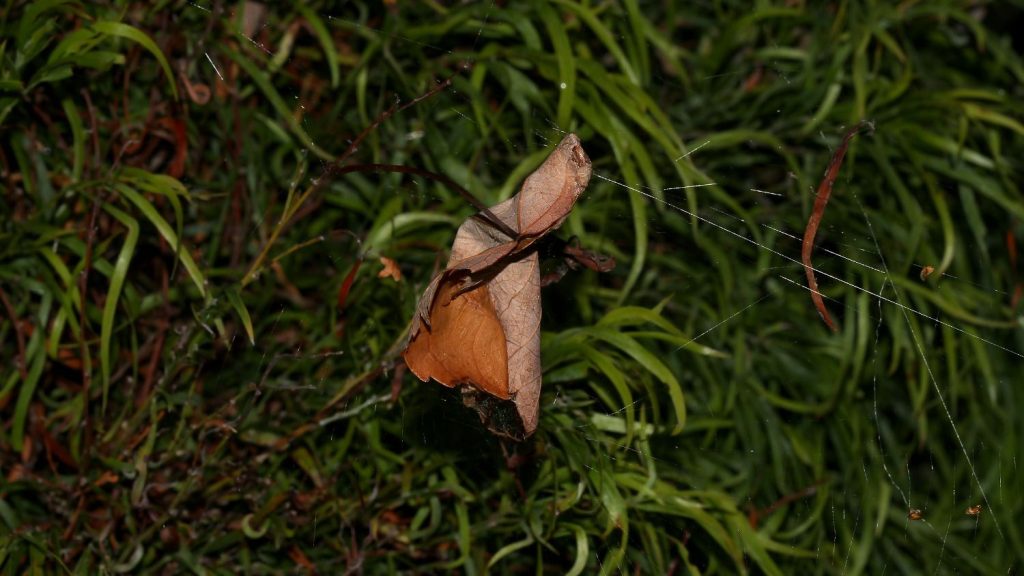
Biology
The leaf-curling spider is commonly found throughout southern Australia in open woodland and forest habitats as well as urban gardens. It normally uses a leaf in the centre of the web for protection, mainly from birds, but many other objects may be used as a shelter in the web including snail shells and old bus tickets. Large numbers of this spider may occur in a localised area; however, unlike the spiny spider, all webs are solitary. Food consists mainly of flying insects. Egg sacs are placed inside a folded leaf suspended some distance outside the main web.
Habitat: Most Leaf Curling Spiders are most common in Summer and they are found in southern areas of Australia. This species constructs a typical orb web and locates at or near the centre of a dead leaf which is curled to conceal the spider. The web-lined leaf conceals the spider during the day but at night the spider leaves its shelter to consume prey which has become entangled in the web. The spider may construct its web in almost any foliage and sometimes several webs may be found in the one small area.
It’s the Leaf Curling Spider, Phonognatha graeffei, of the Tetragnathidae family. Although they are quite common, you don’t always see them out in the open. Often, by day, they are tucked away in their curled leaf retreat. They usually use the native Eucalyptus leaves for their retreat. However, in this case the spider has used a leaf from an exotic Maple tree.
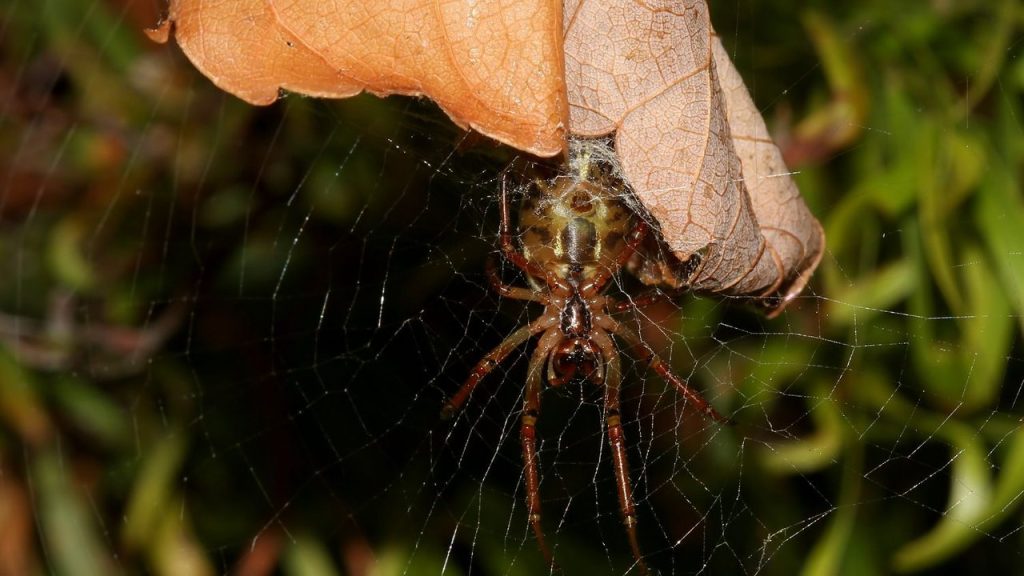
Phonognatha graeffei, referred to as the leaf curling spider, is a common Australian spider found in woodlands and urban areas in the northeastern, eastern and southern states. A small member of the family Araneidae, the orb-weavers, it was previously placed in Tetragnathidae.
The spider is distinguished by having a curled leaf at the centre of its web, in which it shelters. The species form pairs living together in the same leaf, though at opposite ends of their shelter, even before mating at maturity. The female creates a separate curled leaf “nursery” hung in foliage nearby.
The Leaf-curling Spiders (genus Phonognatha) are day-active orb weaving spiders that protect themselves from predators by sitting inside a silk seamed, curled leaf.
Identification
Mainly identified by their curled-leaf retreats in which they hide with only their legs exposed, Leaf-curling Spiders are fat, oval-shaped spiders with red-brown legs and body and a cream coloured pattern on their backs.
Other behaviours and adaptations
Leaf-curling Spiders hoist a leaf from the ground and, using silk threads, curl it to form a protective cylinder, silked shut at the top and open at the hub.. They then sit in this cylinder with only their legs showing, feeling for the vibrations of a captured insect. The curled leaf protects them from birds and parasitic wasps. Sometimes other objects, such as snail shells (which come ready-curled), are used. In P. graeffei this leaf is suspended just above the centre of the web, but may be placed higher in other species. Juvenile spiders start off by bending over a small green leaf, but eventually graduate to larger dead leaves.
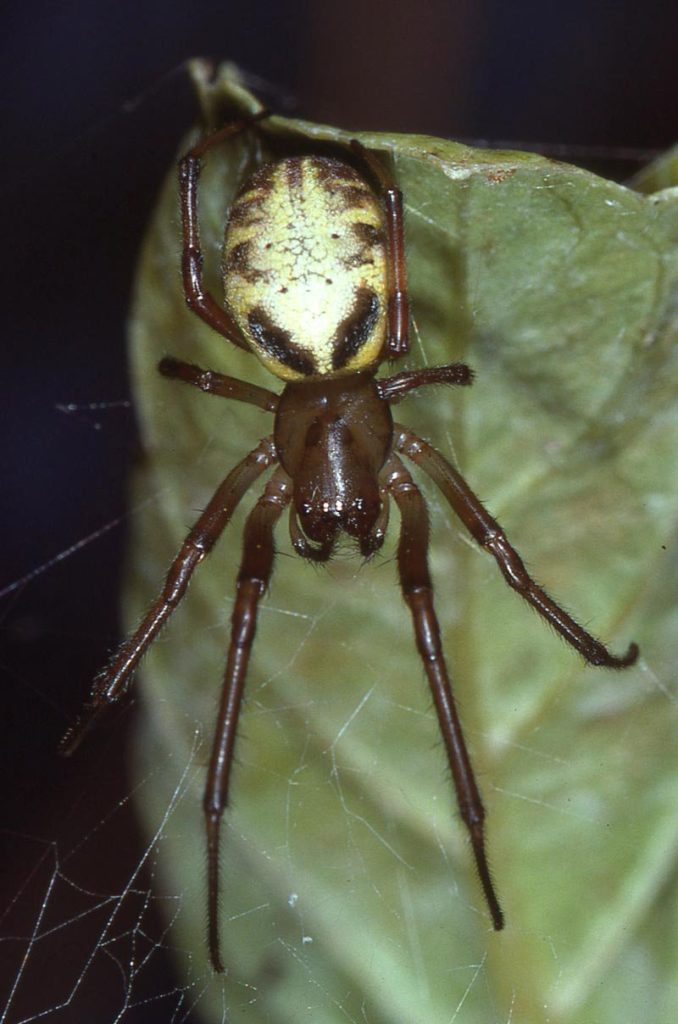
Life history cycle
A male Leaf-curling Spider will take up residence in an immature female’s web, living at the upper end of the curled leaf. He will then mate with her as soon as she matures. The female lays her eggs within another curled leaf, which is silked up and hung in the foliage away from the web.
Predators
The curled leaf retreat protects Leaf-curling Spiders from predators such as birds and parasitic wasps.
Why and how do they curl the leaves?
To make their leafy retreats, these spiders use silk to lift a leaf up from the ground and into their orb web.
Using their legs, they then carefully curl it up and secure it with silk in a funnel or cone shape. They weave this curled leaf into the web using more silk.
If they can’t find a suitable leaf, they might use other objects such as snail shells and pieces of paper.
Young spiders, which aren’t as strong as adults, start by curling up small, fresh green leaves for their retreats and move on to bigger dry leaves as they get older.
The curled leaves – or bits of paper – protect the spider from hungry predators, such as birds. They also shield the spider from parasitic wasps, which lay their eggs on or in the bodies of other insects and spiders, eventually killing their hosts.
The spider can sit safely in their retreat, while keeping their front legs extended and in contact with their orb web. That way, the spider can sense any vibrations caused by an insect trapped in its web – and nip out to grab the food.
Like most other orb-weaving spiders, leaf-curling spiders are not fussy and will eat any insect that happens to get tangled in their web, such as flies, bees, moths and butterflies. They can even handle prey quite a bit bigger than them.
The spiders will spend most of their time in their retreat, only venturing out to get food in the day, or to repair and rebuild their webs (usually at night).
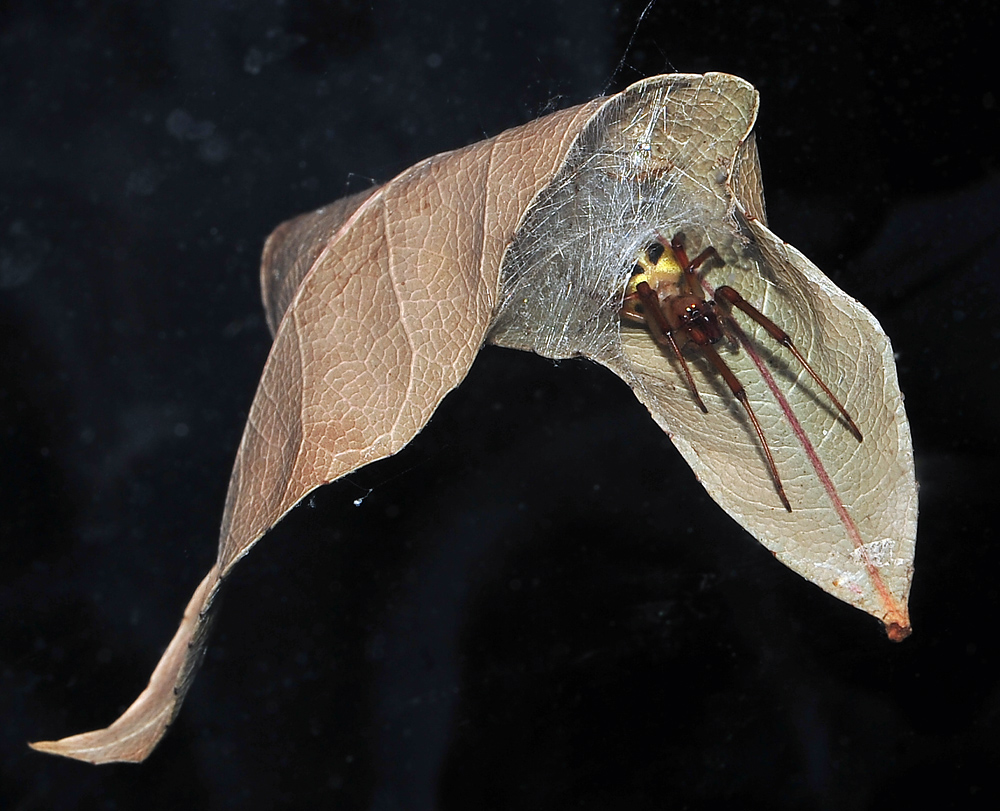
Venomous? Yes. Dangerous? No.
Nearly all spiders you come across are venomous – in other words, they have venom.
But being venomous isn’t the same as being dangerous to humans, and like most spiders, leaf-curling spiders aren’t dangerous to us.
The leaf-curling spider has small fangs that point together, a bit like pincers. Bites are rare. If you hassle one, the spider could try to bite, which may cause localised pain and swelling at the site – but the symptoms are generally mild.
If you spot one, just “leaf” it alone and it will do the same to you.
And remember: having leaf-curling spiders in your back yard is something to be proud of! These fascinating little creatures are great for keeping down pest insects and are a gardener’s friend.
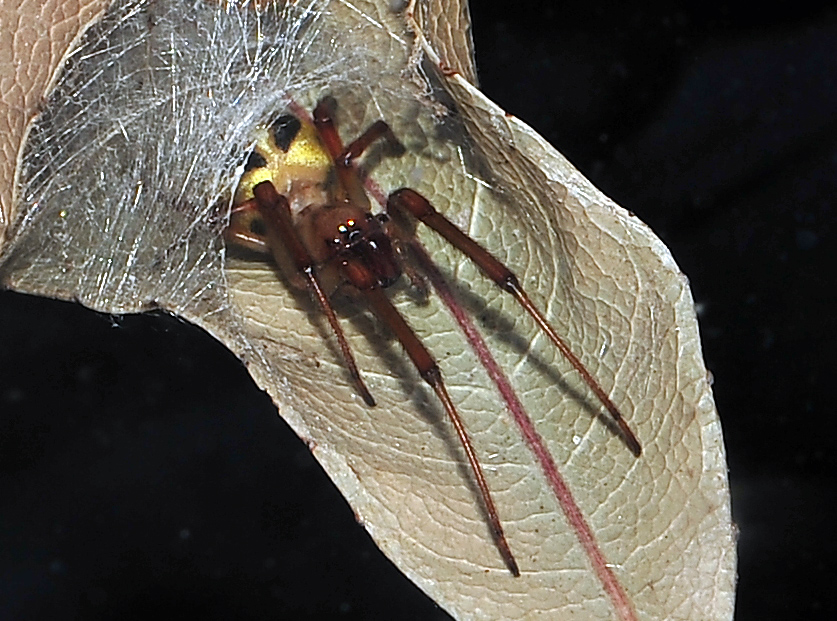
About the Leaf-Curling Spider
Although living together inside the one leaf sounds unusually romantic for spiders, females may cannibalise cohabiting males, independently of whether the female has had food.
Note that dead spiders usually fade in colour, so nearly all the spiders will look blacker or darker in colour in real life than they do in the photos of dead spiders from the museum.
Venom:
The Leaf Curling Spider’s bite gives mild local pain. This species of spider does not appear to be harmful. It can kill larger insects than itself. To humans, the bite causes itching and swelling.
Prey:
This spider constructs a web during the night and many small creatures such as aphids, ants, mosquiotes, small grasshoppers and lady beetles which get caught in this net of silk, are immobilised by the spider and its body fluids are eaten. The web is cut away so that it is not present the next morning.
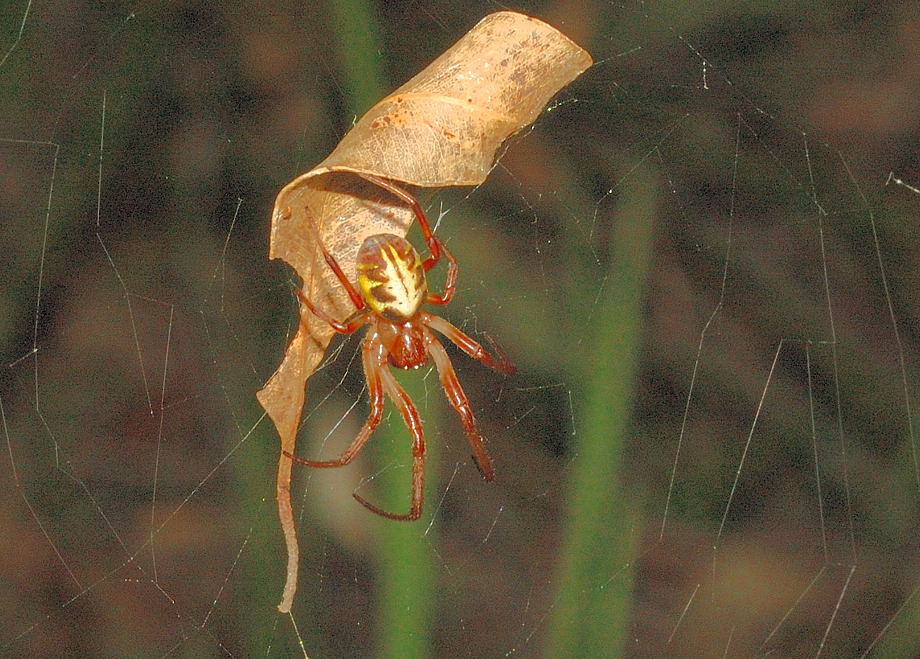
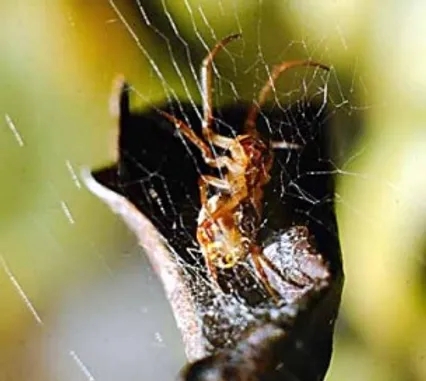
Breeding:
During mating, the male spider visits the boundary of the orb web of the female spider. The egg sacs are made of loose silk thread in the centre of which, the eggs are located. Spiderlings survive weeks without food. When conditions improve, they spin a long thread of silk on which they are carried away and contruct a typical web.
Conclusion:
The Leaf Curling Spider is one of nature’s expert builders. This spider could be called one of the engineers of the animal world.
